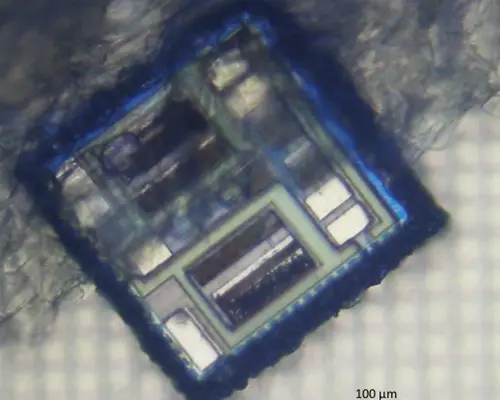MICREAgents: Revolutionizing Programmable Electronic Chemistry at the Microscale
MICREAgents is a collaborative project in Unconventional Computing (UComp) funded byFuture Emerging Technologiesin theEU FP7 program
(start 1/9/2012)
The central idea of the project is to create a programmable microscale electronic chemistry, that employs circuit elements (including super capacitors and energy harvesting) on autonomous self-assembling microscale particles (target ≤ 100 µm maximal dimension) in solution, which we call lablets, to direct reversible association (binding) between them and control access to and chemical reactions in the resulting enclosed reaction compartments:
Summary
MICREAgents is a three-year collaborative project focused on Unconventional Computing, funded by Future Emerging Technologies (FET) within the EU FP7 program. Ten research groups from across Europe (including Israel), along with a research team from New Zealand, have joined forces, coordinated by Ruhr Universität Bochum, to explore a new type of embedded computation where innovative artificial entities combine electronic and chemical functionalities.
The project's core concept is to develop autonomous, programmable microscale electronic chemistry on suspended particles, roughly the size of mammalian cells. These particles, called lablets (target size 100µm), use autonomous circuit components (including power scavenging) and an active microstructured profile to self-assemble in solution. Once assembled, they can communicate and exchange chemicals. The electronic processing will allow them to not only direct their association in a reversible manner but also to control chemical reactions within the assembly-created reaction space. The pairwise association can then be programmed, with electronic signals guiding complex microscopic chemical synthesis or analysis tasks. This process requires a code, similar to the genetic code, and will introduce a new form of computation that links reaction processing with computation in autonomous mobile smart reactors. It marks a significant step forward in integrating computation with reactive chemical processes in electronically programmable systems, representing a radical fusion of autonomous chemical experimentation and a novel computing approach.


The project successfully designed and built the first lablets, incorporating a supercapacitor for rechargeable power (20 minutes of operating time), which led to an increase in size from 100x100x35µm (CMOS1) to 100x200x50µm (CMOS2), and ultimately to 140x140x50µm (CMOS3). A fabrication method was developed to reduce the size of the final lablets back to 100x100x50µm by positioning the supercapacitor on the backside with Through-Silicon Vias (TSVs). Additionally, a smart docking surface and addressable lablet arrays were created, proving to be valuable not only for testing and interacting with the lablets but also for adaptively controlling chemical concentrations in thin films. This system enabled reversible ion uptake and release, regulating downstream DNA processing for DNAzymes and facilitating combinatorial optimization of surface coatings (such as catalysts). The sensor functionality in the docking system enabled all-electronic integrated experimentation. Various powering methods for the lablets, including bipolar power and power through the dock, were investigated, with proof-of-principle demonstrations using supercapacitor coatings to meet performance requirements. The reversible docking process required a novel chemical approach involving pH-sensitive DNA structures to form electrode-targeted gels, which were tested on passive lablets for reversible electronic triggering. DNA and pH sensors were also developed for integration into the lablets. Chemical synthesis methods were employed to facilitate DNA transfer between surfaces for lablet-lablet chemical communication. The lablets and docking systems were explored for potential controlled drug release applications, with examples of electro-triggered release of liposome contents successfully implemented.
Impact
Transformational impact on science, technology and/or society
The general grand challenge that MICREAgents addresses is to integrate ICT with dynamic ICT-Construction. So far, only living systems are able to seamlessly integrate ICT and production, and they are neither fully interfaced to, nor fully programmable by, us. We contend that this can eventually be achieved using biological information encoding principles at the molecular level, when combined as in MICREAgents, with electronically programmable autonomous local manipulation systems. MICREAgents will take a major step in this direction and inspire a flurry of international research activity that will lead directly to achieving this grand challenge. This role of piloting major disruptive paradigm shifts is an important one for FET, and is both a scientific and a technical challenge.


Phases
In phase I of the project, we will simplify some of the energy harvesting problems and the programming and communication problems by having the lablets interact not with one-another but with a nano-structured docking surface (which will be connected electrically to a personal computer). The transient reaction chambers will then be made by association between free floating lablets and the surface (actually lablets embedded in the surface), rather than between arbitrary pairs of lablets. Power will be coupled to the solution lablets by capacitative coupling and stored in an integrated supercap.
In phase II of the project, we shall extend association to include solution lablet-pairs and thus to reaction chambers formed between pairs of autonomous lablets. A surface will still be employed to program and power up the lablets, e.g. capacitively, but lablet-lablet pair interactions will be the focus of attention. We will investigate also domino style lateral transfer of chemicals between neighboring lablets on the surface.
In phase III, solar or electrochemical power and optical programming may be used to remove the docking surface altogether and provide full 3D scalability. Also in this phase, we will investigated ternary interactions between lablets, in the form of free floating domino double lablets that can bind to two singlet lablets. This will allow reactor contents to be transferred directly between lablets.